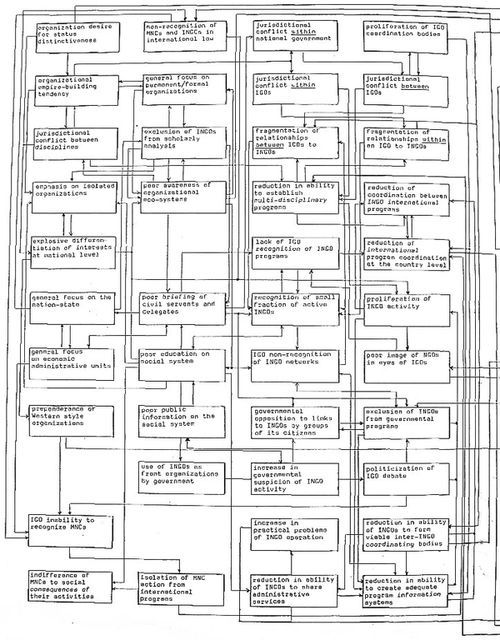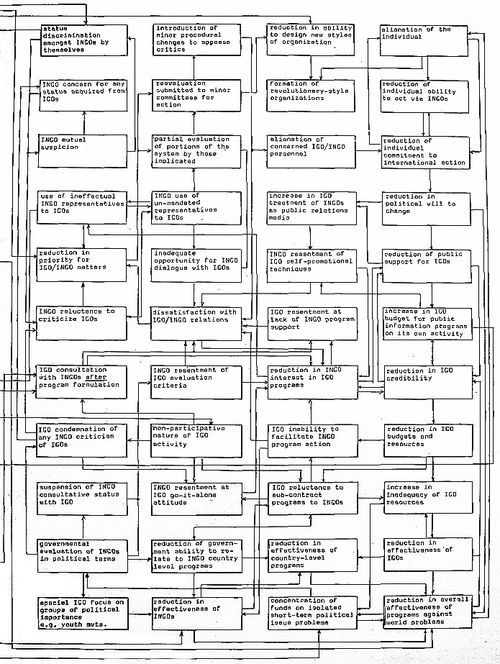A technique illustrated by relations between IGOs and INGOs, particularly for the case of the United Nations system (Part #1)
Previously published in International Associations 24, August-September, pp. 414-417. In 1971 the Union of International Associations did a preliminary study to establish the feasibility of producing a comprehensive map of world problems. From August 1972, in association with Mankind 2000, it worked on the preparation of a Yearbook of World Problems to describe and interrelate the, possibly several thousand, problems which are the concern of different international bodies. The following text accompanied the announcement of this.
Introduction
It is becoming widely accepted that world problems do not exist in isolation from one another. They are linked together in complex networks of causeeffect relationships. Social problems contribute to economic problems which both interact with education problems, health problems and agricultural problems. We have not yet begun to understand all these interlinkages. The Club of Rome sponsored study (See : Quo Vadis UNO. International Associations, 1971, 10) at M.l.T. under Dennis Meadows attempted to study some key relationships using computer techniques. This project has sparked off much enthusiasm and further projects (A new body is being created in Paris called the Institute for Systemic Analysis) - but it has also given rise to much countercriticism. The situation is not clear, but whatever the outcome there is a consenus that we need to be able to look at networks of problems. The following paragraphs describe a very symple technique for clarifying one's own perception of any network of problems with which one is concerned.
Objective
Any executive faced with a maze of problems in his organization's environment can usually, note down 510 key problems. If asked, he can usually show some of these problems are dependent upon other problems - but beyond that point the exercise becomes unprofitable because the situation gets too complex and it is not clear how he could usefully display the interrelationships in a manner which he and his colleagues can comprehend.
It was precisely this difficulty that faced the Union of International Associations in preparing for its Seminar on the Philosophy of International Nongovernmental Organization (Milan, 17-19 May, 1972) in attempting to show the linkages between all the different issues surrounding the current crises in the relations between IGOs and NGOs.
Technique
At first an effort was made to note down all the problems in boxes on a large sheet of paper and draw in the cause-effect arrows between them. This proved totally impracticable because there were too many groups of linked problems and no satisfactory means of juggling them all into position on one satisfactory diagram. This approach was therefore abandoned, except as a useful way of looking at groups of closely related problems in a comprehensive manner. The method finally adopted was to :
1. Note down each problem on a separate card (12 x 8 cm);
2. Number each card in sequential order (in the UIA case it was from 1-88 marked in the upper left hand corner of the card);
3. Use the same identifying numbers to label the linked problem boxes on the sketches prepared in the preliminary attempt.
4. Mark the linkages (identified in the preliminary attempt) between the problem boxes into the set of cards.
- the numbers of the problems which the problem-on-the-card causes or aggravates, namely outgoing links, are clearly marked (in the UIA case, in the bottom right hand corner of the card in question)
- the numbers of the problems giving rise to or aggravating the problemon-the-card, namely incoming links, are clearly marked (in the UIA case, in the bottom left-hand corner of the card in question). Any new linkages between two problems can of course be marked in at any time.
5.The object is then to sort out the cards in a manner which groups closely related problems together. There may well be a space limitation (e.g. getting the complete problem map onto double-folio) which will govern : a) the size of boxes to be allocated to the text on each card, b) ,the number of columns of boxes c) the number of rows of boxes. The sorting operation is a matter of time, patience and successive approximation to a best fit.
6. Once the cards are sorted, the text on the cards can be typed onto a sheet with columns of empty boxes already drawn for all the problems. The number of the problem should also be typed in (from the upper left hand corner in the UIA case).
7. Arrowed lines can now be drawn between each numbered problem box on the basis of the other numbers on the cards, indicating to which problems it is linked (i.e. in the UIA case, the numbers from the tower lelt and right hand corners of the cards). These are the inter-problem linkages. The numbers in the boxes may now be erased. The above procedure gives a comprehensive map of all the problems and their interlinkages. Inspection of the finished map however may suggest other linkages which should also be drawn in.
Preparation of the problem map in this way may over-emphasize some problems at the expense of others. To compensate, it is of course possible to look at a particular problem and decompose it into subproblems (i.e. replace one box by several interlinked as a system), or alternatively to combine several into one.
Example
The map below is the result of the UIA exercise at looking at many of the problems touching on the relationship between IGOs and NGOs. This map was originally started with a view to inclusion in: Anthony Judge and Kjell Skjelsbaek. International nongovernmental organizations and theirs functions. In: A.J.R. Groom and Paul Taylor (Eds.) Functionalism; theory and practice in international relations. London, University of London Press, 1973.The boxes are grouped together into problem sub-systems whose boundaries could have been marked by dotted lines. This was not done because it increased the visual complexity of the flow-chart in this case. An attempt was made to have the fundamental causes in the top left hand corner, and the final results in the bottom right hand corner.
| Experimental map of world problems | |
 |  |